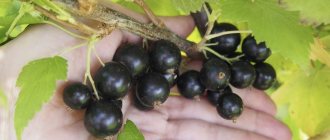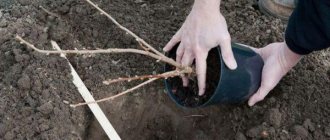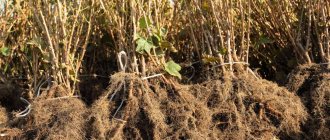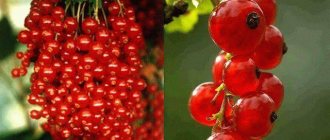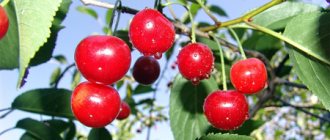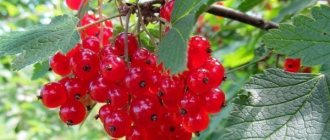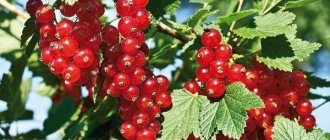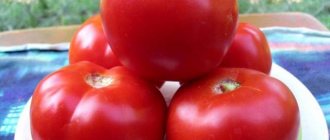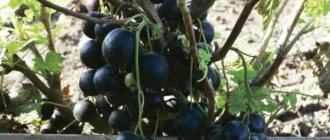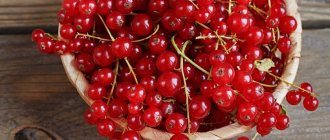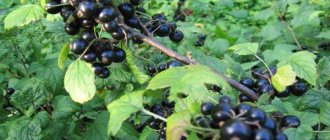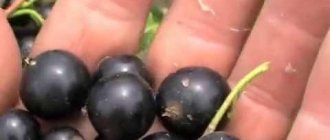Red currant Vixne is a Latin variety, hence the unusual name. There are early and medium ripening bushes; this is convenient because the plant can be grown in any region of the country. Currant Viksne bears juicy and tasty red fruits.
Currant Viksne
Viksne currant berries are large and strong
Viksna currant contains few seeds
Description of the hybrid
Vikse red currant is very popular among gardeners. Outwardly it looks very attractive and does not require special care.
Bushes
The branches are spreading, about 1.5 m long. Large shoots, smooth, gray-brown in color. The buds are long, small, slightly deviated. The leaves have 5 lobes, the edge with waves of a dark green hue. The surface is smooth, slightly pubescent at the bottom. Medium-sized teeth, pea-shaped. The flowers are small, located on large leaves.
Berries
Average weight - 0.8-0.9 g. Round in shape, veins visible. The fruits have a rich aroma with a sweet and sour taste. At the tasting exhibition, professionals rated the taste almost 5 points. The pulp contains a small amount of seeds, the peel is not thick, but quite durable.
Pomegranate berries have a bright red hue to the fruit and are sometimes called cherry berries. The fruits contain pectin (2.5%) and vitamin C (about 35 mg per 100 g).
Fully ripened fruits do not dry out or rot; they can hang on the plant for quite a long time, and after a while they will not lose their presentation.
A substance such as pectin helps remove harmful substances from the body.
Characteristics and description of Viksne currant variety, planting and care
Viksne currant variety is very popular among gardeners. This crop has high yield parameters and has a good taste. This is what many summer residents actively grow. To achieve good results, it is recommended to water the plant on time, feed it and prune it. It is imperative to protect the bushes from diseases and pests.
Characteristics of red currant Viksne
Currant Viksne is often found in summer cottages. This is due to the good taste and unpretentiousness of the plant.
History of selection and habitat
Currants were selected in Latvia. She appeared at the Ogre fruit and vegetable station, which is responsible for the selection of new varieties. The authors of the culture were A. Viksne and T. Zvyagina. They managed to obtain a new variety from the seeds of the Varshevich variety, which has an unusual fruit color. In 1997, the variety was included in the register of the Russian Federation.
Botanical description of the bush
The bush is considered vigorous and is distinguished by a medium-spreading crown, which has an irregular shape. The shoots are thick and straight. They have a dark brown tint and a thick coating. The leaves are large in size and dark green in color.
Flowering and fruiting
The flowers are medium in size and deep saucer-shaped. The sepals are pale in color and covered with purple stripes. Flowering begins in May, and the fruits ripen in mid-July.
The brushes reach 15 centimeters and have a cylindrical shape. The berries are medium in size and weigh 0.8 grams. They are characterized by a sweet and sour taste.
Productivity and scope of application of berries
This variety is considered high-yielding. It begins to bear fruit 2-3 years after planting. If you carry out planting work in early autumn, you will be able to harvest a small harvest in the summer - 2-3 kilograms of currants.
The most abundant harvest can be harvested after 5-6 years. With proper care, currants produce up to 10 kilograms of juicy fruit. On average, yield parameters are at the level of 5-7 kilograms.
Currants are considered universal. It is frozen, eaten fresh and processed. Due to the large amount of pectin, the fruits are used to make jelly, jellies, and jams. The white variety produces a delicious wine.
Variety varieties
This currant has 2 main varieties, which are associated with the color of the fruit.
Currants are characterized by dark red fruits. That is why it is often called pomegranate.
Beloplodnaya
The white variety produces berries of a white-yellow hue.
Pros and cons of culture
This variety of currants has a number of advantages:
- frost resistance;
- resistance to drought and sudden temperature fluctuations;
- stable yield;
- resistance to anthracnose;
- wonderful taste of fruits;
- good commercial quality of berries;
- the possibility of berries remaining on the bush for a long time.
At the same time, the Viksne variety also has certain disadvantages:
- risk of damage by gall aphids;
- the likelihood of fruit buds freezing;
- the likelihood of small and sour berries appearing due to insufficient watering;
- short shelf life of fresh fruits.
Features of planting and care
If planting work is carried out correctly and agrotechnical measures are strictly followed, you will be able to get a good harvest.
Requirements for growing conditions
Open areas that are well lit are suitable for the plant. The culture also develops normally in partial shade. Currants are considered a moisture-loving plant, but can hardly tolerate stagnation of liquid. Therefore, when planting, it is imperative to organize drainage.
The plant develops normally in loamy and sandy loam soil. Optimal pH parameters are 6-6.5. Do not plant the crop in heavy soil with a high clay content. This will negatively affect the development of roots and cause them to weaken.
Timing and planting process
It is best to plant currants in early autumn - this can be done in late September or early October. There should be 2-3 weeks left before persistent frosts. This time is enough for the seedling to adapt to new conditions. The temperature when performing planting work must be at least +6 degrees. In spring, the young plant will produce shoots. At the same time, in July it will be possible to get a small harvest.
It is allowed to plant currants in early spring. However, this should be done before the buds appear. The currants will grow throughout the year. In this case, the harvest will be possible in the second year after planting. If frosts appear in October and there is a risk of early cold weather, planting work is postponed until spring.
Before planting a bush in the ground, it is recommended to carefully inspect it and cut off affected and dried fragments.
To carry out planting work, you should do the following:
- Dig holes 40-45 centimeters in size. The distance between bushes should be at least 1.5 meters.
- Fill the cavity 2/3 full with the special mixture. To do this, you should combine 2 parts of compost, 1 part of humus, 60 grams of potassium fertilizer and 250 grams of superphosphate.
- Pour 5 liters of water into the hole.
- Spread the roots and immerse the bush in the hole. This is done at an angle of 45 degrees.
- Cover the bush with soil. The root collar should be deepened by 6 centimeters.
- Lightly trample the soil and water it with water.
- Trim shoots. Each of them should have a maximum of 4-5 buds.
In dry weather, it is recommended to moisturize currants. It is especially important to water it during fruiting, which occurs in July and August. You should pour 1 bucket of water under the bush.
It is recommended to water the plant at intervals of 10-14 days.
Protection from winter cold
Although the variety is considered frost-resistant, young plants need shelter. The soil around them should be mulched with hay or straw. If there is a lot of snow in winter, it is poured into a depression near the trunk.
Diseases and pests: prevention and treatment
Currants are resistant to pests. At the same time, the gall aphid poses a danger to it. It causes red blisters to appear on the leaves. As a result, there is a risk of the bush dying. In such a situation, the affected leaves should be torn off and burned.
The plant also suffers from glassworm invasion. Insects gnaw out the middle of the shoots. As a result, the currants dry out. In such a situation, the bush is removed.
The plant is resistant to anthracnose. But at the same time it suffers from septoria or goblet rust. Medications containing copper will help cope with problems.
Reviews from gardeners about the variety
Numerous reviews about the plant confirm the popularity of the variety:
- Marina: “I’ve been growing Viksne currants for several years now. Culture is universal. She is low maintenance. The fruits have excellent taste. At the same time, the plant requires preventive spraying against aphids.”
- Andrey: “I planted Viksne currants several years ago. I am very pleased with the result. The berries have a pleasant hue and are slightly sour. They are great for compotes and juices.”
Viksne currant is a popular variety grown by many gardeners. To achieve good results and get an excellent harvest, it is important to provide the crop with quality care.
Source: https://MoeFermerstvo.ru/smorodina/viksne
Varietal features
It is a mid-early bush that has excellent yields. The bush is not particularly afraid of viruses, heat and cold, and is ideal for cultivation in any region of the country.
Ripening time and yield
This variety of shrub produces a high and constant harvest. If planting is carried out in September, then in July you can get a very small, but tasty harvest (about 2 kg). At the end of spring the bush begins to bloom, and in mid-summer the berries ripen.
The gardener will receive the greatest harvest in the 5-6th year after planting the bush. In good weather and favorable conditions, it is possible to remove approximately 10 kg of fruit. On average this figure is 6 kg.
From 1 hectare of land you can get about 16-18 tons of currants, this is a good indicator for this crop.
Application
Viksna is distinguished by its unique use. It can be eaten fresh, which is what it is grown for; the berries are frozen or canned. Pectin helps create jam and compote.
The beneficial properties of currants help to quickly cope with high fever and weakness in the body. The juice of the plant's berries not only quenches thirst, but also acts as an anti-inflammatory drug. Red fruits help blood circulate throughout the body; Vixne is used as a preventive product against heart attacks.
Transportability
Vixne is an excellent variety for growing on a large scale. The fruits have a reliable peel, so they are not afraid of transportation. In addition, the berries hang on the currant for a long time and do not rot.
Resistance to diseases and pests
The currant bush has strong immunity and resists fungal diseases, but is often attacked by aphids. To prevent the insect from even approaching the plant, you need to constantly destroy weeds, because they are a breeding ground for the pest.
Anthracnose also causes harm; its main symptom is reddening of the foliage. The variety is not particularly resistant to this disease. To prevent rotting of the root system of the crop, you need to water the bush on time and not plant in areas with close groundwater.
Drought and frost resistance
Viksne is a cold-resistant variety. Wind and too low temperatures will not significantly damage the bush, but they can lead to a deterioration in the condition of the fruit buds. This will not affect the harvest, as they will return to shape in the spring.
The variety does not like drought and heat, so if during this period it does not receive enough water, the berries will become much smaller and smaller in size.
Other criteria for choosing red currants
When choosing a variety, gardeners are guided not only by its suitability for cultivation in a particular region. Other characteristics of currants are also important for them.
Winter-hardy varieties
For open ground, you should choose plants that can withstand winter cold. These include:
- Scarlet Dawn;
- Lights of the Urals;
- Ural beauty.
Scarlet Dawn
Resistant to diseases and pests
In order to treat garden plantings with fungicides and insecticides as little as possible, it is necessary to select varieties of red currants that are resistant to diseases:
- Gazelle;
- Tisel.
They are undemanding in care and produce crops suitable for transportation over long distances. The taste of the berries of these varieties is excellent.
Gazelle
Large-fruited
Large currants are best suited for fresh consumption. It’s nice to show off such a harvest to your neighbors, as well as surprise your relatives. Popular varieties include:
- Asora;
- Alpha;
- Baraba.
Self-fertile
To obtain stable yields, preference should be given to self-fertile red currant varieties:
- Transdanubia;
- Creamy.
Transdanubia
They are characterized by high productivity, as well as excellent taste of ripe fruits. They can be grown even in unfavorable climatic conditions.
Productive
Breeders presented varieties with high yields to gardeners:
- Early sweet;
- Andreichenko;
- Dana;
- Alpha.
They delight with an abundance of fruits, but at the same time they are not without some drawbacks. You can get acquainted with them by studying the characteristics of the variety in detail.
The sweetest
Red currants are distinguished by the fact that their fruits have a sour taste. But especially for connoisseurs of sweet berries, varieties have been bred that are almost devoid of sourness:
- Sugar;
- Sarah.
Sugar
They are used not only for fresh consumption, but also for processing and preparation.
Seedless
Not everyone likes the fact that small red currant fruits contain seeds. Seedless varieties have been bred especially for such gourmets:
- Rose;
- Valentinovka.
New
Every year, breeders work tirelessly and bring to the market new varieties of red currants with improved characteristics, increased immunity, frost resistance or drought resistance. Among their latest achievements are:
- Marmalade;
- Ilyinka;
- Long-haired.
All three varieties are united by the fact that the taste of their fruits has a barely noticeable sourness and is liked not only by adults, but also by children.
Previous CurrantsBenefits and harms of red currants for the human body Next CurrantsThe best varieties of black currants according to different criteria
Advantages and disadvantages
The Viksne currant bush, like other crops, has its pros and cons; they must be taken into account when planting the plant.
Advantages of the variety:
- survives low temperatures, wind and cold even without special shelter;
- relative drought resistance;
- tolerates unexpected changes in temperature and weather generally well;
- brings a high and tasty harvest;
- the fruits are marketable;
- transportable.
Disadvantages of the variety:
- does not survive an aphid attack well;
- the kidneys freeze, which then take a long time to recover;
- during hot weather and without proper watering, the berries become smaller;
- fresh harvest is not stored longer than 2 weeks.
Overripe and unripe fruits contain several times less useful microelements.
Pros and cons of culture
This variety of currants has a number of advantages:
- frost resistance;
- resistance to drought and sudden temperature fluctuations;
- stable yield;
- resistance to anthracnose;
- wonderful taste of fruits;
- good commercial quality of berries;
- the possibility of berries remaining on the bush for a long time.
At the same time, the Viksne variety also has certain disadvantages:
- risk of damage by gall aphids;
- the likelihood of fruit buds freezing;
- the likelihood of small and sour berries appearing due to insufficient watering;
- short shelf life of fresh fruits.
Landing Features
You can grow a productive plant only if you follow the planting recommendations.
Landing dates
It is better to plant Vixna in the fall. There should be half a month left before the first frost so that the cuttings have time to gain a foothold in time. In the spring season, the plant produces its first shoots.
You can plant a bush in March, but this should be done before the sap begins to flow. The plant will grow all year round. The first harvest will be harvested only in the 2nd year after planting the bush. If in mid-autumn it has already become very cold and the first frosts have occurred, then the plant is planted in March.
Selection of seedlings
Buy Viksne currant cuttings only from good sellers. The seedling must have a healthy root system and strong branches.
There may be cracks in the bark, and the bark itself peels off - this is a completely normal phenomenon, such a seedling will take root. Pay attention to the absence of foliage and shoots; the best cutting option is a 2-year-old seedling with strong roots.
Site selection and preparation
Vixne takes root and brings an excellent harvest only if the area for planting the bush is properly chosen.
Rules for choosing a place:
- Choose a sunny area, but at the same time protected from drafts. The bush can grow with some shade, but will not survive in a heavily shaded area. The best area is near low buildings.
- Look for a place with moist soil, do not allow it to become swampy.
- The currant bush lives well on light, sandy soils. The roots will weaken in clayey and heavy soil.
- Make the planting area flat or slightly elevated.
- 60 days before planting, clear the area of grass, roots of other plants and debris.
- Dig up the soil so that moisture is better absorbed and the roots can breathe.
- If you plant a seedling in the spring, then carry out all the work in the autumn season of the year.
Currants cannot grow in the same area for longer than 15 years.
Planting process: step-by-step diagram
Before directly planting the seedling, it is necessary to inspect it and remove all dry, damaged areas.
Landing algorithm:
- Dig holes measuring 0.4 x 0.45 m. Maintain a distance between bushes of about 1.5 m.
- Fill the hole 2/3 with a mixture of humus (1 part), peat (2 parts), superphosphate (250 g) and potash fertilizer (60 g).
- Fill the planting hole with 5 liters of water.
- Straighten the roots of the cutting and tilt it slightly, place it in the hole.
- Fill it with soil, deepen the root collar by 60 mm, thanks to this the plant will begin to develop more roots.
- Trample the ground around the bush and water well with cold water.
- Root the shoots, leaving no more than 5 buds on each. This is approximately 0.2 m from the surface of the earth.
- Mulch the soil to prevent rapid evaporation of water.
For information on how to plant red currants in spring and autumn, watch the video:
Agricultural technology
It is best to plant a seedling in early October or late September. Young currants need time to get stronger and take root before the cold weather sets in. Therefore, the time reserve should be from 2 to 3 weeks. Ideally, the air temperature at the time of landing will not be lower than +6 degrees. Shoots will appear in the spring, and by July you can count on the first harvest. This shrub can also be planted in spring. The main thing is to be in time before the kidneys swell. But in this case, the berries will appear only in the second year.
Much attention should be paid to the seedling that is planned to be planted. It is best to give preference to a two-year-old bush. It has already developed roots, and its branches have become woody and strong. If cracks are visible in places on the bark, it’s okay. This is fine. The main thing is that there are no young shoots and leaves.
The next important stage is site preparation. Several rules must be followed:
- The planting site should be sunny and protected from the winds, preferably near a fence or any other hedge;
- Be sure to choose a soil that is moist, but not waterlogged. Groundwater should be no closer than 80 cm from the top layer of the earth;
- The soil must be sandy loam or loamy, light and slightly acidic, otherwise the currant root system may weaken, which will lead to a decrease in yield or even death of the crop.
Read also: Raspberry variety Firebird: description, photos, reviews, secrets of planting and care
Clearing the ground of weeds
Before planting Viksne currants, it is necessary to clear the area of weeds and roots. Then dig up the soil so that the moisture is better absorbed. By the way, this method also optimizes aeration. These manipulations must be carried out several months before the planned landing. If planting work is carried out in the spring, then it is better to prepare the ground in the fall.
It is worth taking a closer look at the intricacies of planting cherry currants:
- To begin with, make depressions in the ground, about half a meter. The distance between seedlings is approximately 1.5 m;
- Prepare a nutrient mixture by mixing humus and peat in a 1:2 ratio and adding 250 g of superphosphate and a little potassium. Wood ash won't hurt;
- Then this mixture is poured 2/3 into the well;
- Don't forget about water. When planting, each hole will require about 5 liters;
- After watering the hole, you need to straighten the roots of the seedling and lower it into the ground at an angle of 45 degrees;
- Fill the hole and lightly press down the soil near the roots;
- Shorten the currant shoots to 15 cm (about 5 buds should remain);
- Mulch to retain moisture.
For good development, proper planting alone will not be enough. You need to know how to care for currants. The Viksne variety is an unpretentious plant. The shrub will have to be watered every 3 days, especially during flowering and berry formation.
Important. In addition, be sure to remove weeds regularly. This is the only way to protect the crop from aphids and soil clogging. It is optimal to loosen the soil around the bush, but not damage the roots.
As for feeding, it is done three times. The first time - before flowering (with urea or ammonium nitrate), the second - during the formation of berries (usually bird or cow droppings), the third - during autumn treatment (potassium and phosphorus mixtures).
Many varieties of currants, among other things, need to be pruned. Viksne is not one of them. It is enough just to remove damaged and dry branches in the spring.
Features of care
Although the Viksne currant bush is undemanding in terms of care, it still needs to be provided with minimal but high-quality care.
Watering
The plant needs water especially during the season of abundant fruiting. It should be poured onto the tree trunk circle. The number of buckets depends on the air temperature and dryness of the ground.
Water twice in 10 days. Pour about 2-4 buckets under the plant, focusing on the size of the bush and the degree of soil moisture. If the soil is still wet, you can refuse watering.
Tree trunk care
The soil circle around the trunk of the bush requires regular maintenance. It is necessary to weed all the grass, because it clogs the soil and prevents the currants from developing normally. In addition, the grass is a source of spread of currant aphids.
After adding water, the soil is loosened and mulched with leaves; such an event will help keep it moist for longer. The root system is not too deep, so you need to process the circle around the plant very carefully so as not to injure the roots.
Feeding
Vixne is fertilized 2 times - after flowering and 2 weeks before the harvest begins to ripen. During the growing season, which begins in May or June, it is necessary to add nitrogen to promote the growth of green mass. Ammonium nitrate (30 g per 1 plant) or urea (30 g per 1 bush) are excellent.
Read useful recommendations for spring feeding of currants on the pages of our website.
After flowering, as well as during the ovary period, bird droppings (1:12) or mullein (1:5) should be added at the rate of 2 buckets per 1 bush. In the autumn season of the year, phosphorus and potassium are added during digging. You can use wood ash, which contains a large number of useful microelements.
If the plant is large with massive leaves and a bountiful harvest, then you don’t need to apply fertilizer in the fall.
The best effect comes from mineral and organic products applied under the bush at the same time. It is necessary to avoid chlorine-containing substances, because currants are very sensitive to this component.
Trimming
In order for the currant to develop quickly, it is trimmed a little after planting and about 3 buds are left on the shoot. Do not touch adult plants, since the old shoots still bear fruit. In spring, you can trim old, diseased and dead branches, but do not touch the top.
Read about pruning in the fall in the next article.
For tips on pruning red currants and forming a bush, see the following video:
Reproduction
The plant reproduces in several ways:
- dividing the bush;
- cuttings;
- vertical layering;
- horizontal layers;
- seeds.
For propagation by vertical layering, the shrub is heavily pruned - almost to the surface of the soil; in mid-summer, young shoots are spudded. In October they are transplanted to the nursery. To obtain horizontal layering, shoots that have taken root are left until the beginning of next spring, then they are bent down and hilled up separately from the main plant.
Preparing for winter
Adult plants do not need shelter, but young, newly planted seedlings will die without it. Plants are covered with fallen leaves.
Harvest and storage
The currant bush is a high-yielding plant. About 6 kg of berries are harvested from 1 bush. Ripening time is mid-summer. The berries are cut together with the clusters, otherwise the crop will be damaged. The fruits are used for large-scale processing; the fresh fruit storage time is 12 days at a temperature of +1... +2 degrees Celsius.
Pruning red currants
Good care of currants involves not only fertilizing and watering, but also proper, timely pruning.
Pruning red currants is somewhat different from pruning its black relative. At the red
Red currant formed on a trunk.
fruit buds are formed at the base of annual shoots and on the ringlets. Ringlets are small shoots on old currant branches, only 2 - 4 cm long. Therefore, the harvest is formed not only on young, but also on old branches. That is why anti-aging pruning of red currants has to be done much less frequently than pruning black currants.
A formed, mature bush should consist of 15 - 20 branches of different ages. To do this, after planting the seedling, every year leave 2 - 3 young, strong shoots growing in different directions, and cut off the rest. Red currant shoots bear fruit for 6-8 years, then they need to be replaced.
In adult bushes, cut off broken, drying, old and low-yielding branches. Old branches are always darker, almost black, and are not difficult to identify. For lightening and thinning, branches that grow from the base of the bush are cut out. Annual shoots cannot be pruned, since there are fruit buds on their tops.
Pruning should be done when the plants are dormant, late autumn or early spring. In summer, it is advisable to pinch the tops of green shoots to activate the formation of replacement shoots.
Watch an interesting video about pruning and shaping currant bushes:
Forming bushes on a trellis
Red currants can be easily grown as a trellis crop. Such bushes are easy and convenient to care for, they are well lit by the sun and suffer less disease. When forming such a bush, you need to leave the shoots growing only in one plane, and cut off the rest. Then secure them to 2 - 3 rows of wire, as they do with grapevines.
Bushes with this molding are convenient to place along walls and fences.
Bushes with this molding are convenient to place along walls, fences or along paths. Just don’t forget to trim or break out shoots that are not growing in a given plane. In all other respects, care is the same as for ordinary bushes.
Formation of standard currants
Some gardeners form red currants in standard form. Then it becomes like a dwarf tree. The result is an original plant with large berries, which is pleasant and interesting to care for.
Formation of standard red currants.
Further pruning resembles caring for a tree; branches growing inside the crown, downwards, and shoots older than seven years are pruned. Of course, you must immediately remove shoots growing from the base of the bush.
In winter, care is not at all difficult. Red currant is a winter-hardy crop, but in severe winters with strong winds and sharp temperature fluctuations, the plant's perennial branches may freeze. If you cover the currants with snow, they will withstand temperatures dropping to -40 - 45 °C. The danger for the plant is spring frosts, during which the flowers and ovary may die.
Care and pest control of fruit bushes without chemicals:
https://www.syl.ru/article/205914/new_smorodina-posadka-i-uhod-uhod-za-smorodinoy-chernoy-i-krasnoy
Diseases and pests
Currants are resistant to many diseases and pests. But aphids are harmful to the plant. Symptoms of its appearance: the presence of blisters and red growths. The insect lays eggs inside the leaf, the emerging larva begins to feed on the sap of the plant, which leads to the death of the currant. Leaves affected by this pest are plucked and burned, and the bush is treated with folk or special means.
How to get rid of aphids on currants, read this article.
If a glass cell appears on the plant, then the currants are completely dug up and burned. Vixne is relatively resistant to anthracnose and has weak immunity to white bloom, goblet rust and septoria. These ailments can only be cured with medications containing copper.
Reviews from gardeners about Viksna currants
★★★★★
Natalya, 30 years old, accountant, Voronezh. I’ve been growing cherry Vixne for myself for 4 years now, and I also sell a little.
The bush is unpretentious and versatile; it is really in demand among customers. The berries are large and round, the seeds are not felt, and are colored in a rich garnet hue. I really like currants, but the only drawback is low resistance to disease, so every year in the spring I spray the bushes with products against diseases and pests. ★★★★★
Alexander, 50 years old, turner, Lipetsk. 2 years ago I bought a cutting of red Vixne; I was attracted by the unusualness of the variety.
This year I tried the taste of berries for the first time, they are really sweet, although there is a little sourness. I brewed excellent compotes in the summer, I collected about 4 kg of harvest from 1 bush, but I think that this is not the limit. Hide
Add your review
The Viksne currant bush is not only easy to care for and plant, but also quite beautiful. During the fruiting season, red berries will perfectly decorate the site, so summer residents plant the plant in the most visible place.
0
0
Copy link
Harvest and storage
Currant “Viksne” is a high-yielding variety. Fruiting 5-6 kg per bush. In the first 2 years, the harvest will be small, up to 3 kg, and under favorable conditions you can get up to 10 kg of berries. Ripening period is mid-July. Currants are collected together with the clusters, otherwise, when torn off, the integrity of the fruit may be damaged.
This variety has good transportability. Used for industrial processing. The storage duration of collected berries at a temperature of +1-2°C is 10-15 days.
Video about the Viksne currant variety.
https://fermilon.ru/sad-i-ogorod/kustarniki/krasnaya-smorodina-viksne.html
https://7ogorod.ru/plodovye-kusty/smorodina-viksne.html
https://poferme.com/sad/kustarniki/smorodina/sort-sm/krasnoy/viksne.html
